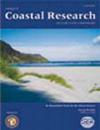Modelling of the Gold Coast Seaway tidal inlet, Australia
4区 地球科学
Q3 Earth and Planetary Sciences
引用次数: 19
Abstract
SENNES, G., CASTELLE, B., BERTIN, X., MIRFENDERESK, H. AND TOMLINSON, R.B., 2007. Modelling of the Gold Coast Seaway tidal inlet, Australia. Journal of Coastal Research, SI 50 (Proceedings of the 9th International Coastal Symposium), 1086 – 1091. Gold Coast, Australia, ISSN 0749.0208 The Seaway entrance is a tidal inlet located on the Gold Coast (Queensland, Australia). Before the 80s, the entrance was highly variable in terms of inlet location and sand bar characteristics. The Seaway stabilisation with two training walls combined with an artificial sand bypassing system were completed in 1986 with the aims of fixing the entrance, maintaining a safe navigable channel, preventing shoreline erosion to the north and a buildup of sand to the south. Despite these training works, the dynamics of the Seaway is still poorly understood: channel infilling problems and navigation issues remain. For these reasons, the present study aims to develop a comprehensive model of the entrance to be used for further dredging and training work issues. The present investigation is carried out in two stages. The first stage is based on historic aerial photograph analysis of the Seaway before training works. It shows that the mouth was periodically driven northward by the longshore drift, with an average cycle time of 10 years. The second stage is based on numerical modelling after training works. Refined Delft3D modelling is undertaken with a 2DH approach on the Seaway area, taking into account the training walls and the sand bypassing system. This local model is coupled with MIKE21 implemented on a regional scale to provide accurate tide and flow forcing at the boundaries. After calibration, the analysis of flow patterns shows that the Gold Coast Seaway is ebb-dominated and that the more intense flow velocities are observed in the northern channel. Morphological evolution of the inlet is also investigated with a qualitative approach. Results indicate the pathways and rate of the sand movement within the tidal inlet in its current configuration and provide information about a planned 400 m extension of the southern training wall. A significant calibration work, involving sediment transport and bathymetry measurement, is required for the model to be used as a comprehensive tool for further dredging and dumping strategies within the entrance.澳大利亚黄金海岸海道潮汐入口建模
Sennes, G., Castelle, B., Bertin, X., Mirfenderesk, H. and Tomlinson, R.B., 2007.Modelling of the Gold Coast Seaway tidal inlet, Australia.Journal of Coastal Research, SI 50 (Proceedings of the 9th International Coastal Symposium), 1086 - 1091.澳大利亚黄金海岸,ISSN 0749.0208 Seaway 入口是位于黄金海岸(澳大利亚昆士兰州)的一个潮汐入口。上世纪 80 年代以前,该入口在入口位置和沙洲特征方面变化很大。1986 年完成了海道加固工程,包括两道加固墙和一个人工海沙旁路系统,目的是固定入口,保持安全的通航航道,防止北面海岸线被侵蚀和南面海沙堆积。尽管进行了这些整治工程,但人们对该航道的动态仍然知之甚少:航道填充问题和航行问题依然存在。因此,本研究旨在开发一个入口综合模型,以用于进一步的疏浚和培训工作。本次调查分两个阶段进行。第一阶段是基于对培训工程前航道的历史航拍照片分析。结果表明,海口被沿岸漂流定期向北推进,平均周期为 10 年。第二阶段基于训练工程后的数值模拟。采用二维水深法对海口地区进行了 Delft3D 精细建模,其中考虑到了训练墙和绕砂系统。该本地模型与在区域范围内实施的 MIKE21 模型相结合,可在边界提供准确的潮汐和水流动力。校准后,对水流模式的分析表明,黄金海岸航道以退潮为主,北航道的流速较大。此外,还采用定性方法研究了入海口的形态演变。研究结果表明了潮汐入海口内沙子运动的路径和速度,并提供了有关计划中的南侧训练墙 400 米延伸段的信息。需要进行大量的校准工作,包括沉积物运移和水深测量,才能将模型用作入口处进一步疏浚和倾倒策略的综合工具。
本文章由计算机程序翻译,如有差异,请以英文原文为准。
求助全文
约1分钟内获得全文
求助全文
来源期刊

Journal of Coastal Research
地学-地球科学综合
自引率
0.00%
发文量
87
审稿时长
3-8 weeks
期刊介绍:
The Journal of Coastal Research (JCR) is one of the leading international journals for coastal studies and processes, and is published bi-monthly by the Coastal Education & Research Foundation [CERF]. By covering the entire field of coastal research, the JCR encompasses all subjects relevant to natural and engineered environments (freshwater, brackish, or marine) and the protection/management of their resources in the vicinity of coastlines of the world. Even though the journal broadly focuses on immediate shoreline zones, the JCR also embraces those coastal environments that either reach some indefinite distance inland or that extend seaward beyond the outer margins of the sublittoral (neritic) zone. The JCR disseminates accurate information to both the public and research specialists around the world on all aspects of coastal issues in an effort to maintain or improve the quality of our planet''s shoreline resources.
 求助内容:
求助内容: 应助结果提醒方式:
应助结果提醒方式:


